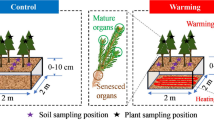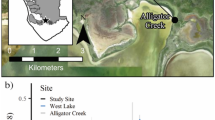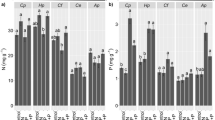Abstract
Prior to anthropogenic disturbance, the floodplains of the Illinois River (USA) experienced moderate, cyclical flooding; a phenomenon termed a 'flood pulse'. Significant changes in the hydrology of the Illinois River caused by human alteration of the river channel resulted in a decline in populations of Boltonia decurrens, a native, herbaceous floodplain species of the Illinois River Valley and the demography of the species and underlying mechanisms causing the severe decline of B. decurrens are currently being studied. One component of the river flood pulse is the increased availability of nutrients in floodplain soils. We studied the effects of increased nutrient availability on growth and reproduction of B. decurrens and Aster pilosus, a species replacing B. decurrens in the floodplain. In this study, we examined the effects of a spring nutrient pulse and a late summer nutrient pulse, as compared to a control treatment, on rosettes of B. decurrens and A. pilosus grown in three soil types: sandy loam, silty loam and clay. Biomass, plant height, inflorescences per plant, seed production, and seed mass were measured and compared. Individuals of B. decurrens grown in sandy loam, the predominant soil type of the Illinois River Valley, had thegreatest increase in growth and fecundity in response to nutrient pulsing. Total biomass and inflorescences per plant were significantly greater than the control regardless of the timing of the nutrient pulse. Aster pilosus did not exhibit a clear pattern of increased growth and fecundity in a specific soil type or pulse treatment. The early pulse treatment appeared to have a greater effect across the range of soil types than the late pulse treatment; however, it did not seem to influence any particular variable(s) that we measured. A pulse of nutrients benefits B. decurrens more than A. pilosus, particularly in sandy loam. The increased vigor and fecundity of B. decurrens with a nutrient pulse could be a factor contributing to population survival during the period between disturbance events.
Similar content being viewed by others
References
Baskin, C. C. & Baskin, J. M. 1988. Germination ecophysiology of herbaceous plant species in a temperate region. Am. J. Bot. 75: 286–305.
Bayley, P. B. 1991. The flood pulse advantage and the restoration of river-floodplain systems. Regulated Rivers: Res. Manag. 6: 75–86.
Bayley, P. B. 1995. Understanding large river-floodplain ecosystems. BioScience 45: 153–158.
Bellrose, F. C. 1941. Duck food plants of the Illinois River Valley. Illinois Nat. Hist. Survey Bull. 21: 237–288.
Bellrose, F. C., Havera, S. P., Paveglio, F. L. & Steffeck, D.W. 1983. The fate of lakes in the Illinois River Valley. Illinois Natural History Survey, Springfield, Report no. 119, pp. 1–27.
Bellrose, F. D., Paveglio, F. L. and Steffeck, D. W. 1979. Waterfowl populations and the changing environment of the Illinois River Valley. Illinois Natural History Survey, Springfield, Report no. 32: 1–51.
Belt, C. B. 1977. The 1973 flood and man's constriction of the Mississippi River. Science 189: 681–684.
Benner, B. L. & Bazzaz, F. A. 1987. Effects of timing of nutrient addition on competition within and between two annual plant species. J. Ecol. 75: 229–245.
Brethauer, K. 1997. The availability of soil nitrogen to Boltonia decurrens, a threatened floodplain species, and Boltonia asteroides, a non-threatened, related species. [Masters]. Southern Illinois University, Edwardsville, IL.
Changnon, S. A. 1996. The great flood of 1993: causes, impacts and responses. Westview Press Inc., Boulder, CO, 319 pp.
Fitter, A. 1986. Nutrient acquisition. In: Crawley, M. J. (ed.), Plant ecology, 2nd edition Blackwell Science, London, 717 pp.
Herkert, J. R. 1991. Endangered and threatened species of Illinois: status and distribution, Vols. 1 and 13, Illinois Endangered Species Protection Board, Springfield.
Hoagland, D. R. & Arnon, D. I. 1938. The water culture method for growing plants without soil. California Agriculture Exp. Sta. Cir., Berkeley, CA. Report no. 347.
Hutchinson, G. E. 1951. Copepodology for the ornithologist. Ecology 32: 571–577.
Junk, W. J., Bayley, P. B. & Sparks, R. E. 1989. The flood pulse concept in river-floodplain systems. In: Dodge, D. P. (ed.), Canadian Special Publications in Fisheries and Aquatic Sciences, Canada, pp. 110–127.
Lant, C. L. & McCorvie, M. R. 1993. Drainage district formation and the loss of Midwestern wetlands, 1850–1930. Agric. History 67: 33–34.
Mattingly, R. L., Herricks, E. E. & Johnston, D. M. 1993. Channelization and levee construction in Illinois: Review and implications for management. Environ. Manag. 17: 781–795.
Middleton, B. A. 1999. Wetland restoration, flood pulsing and disturbance dynamics. John Wiley and Sons, Inc., New York
Mills, H. B., Starrett, W. C. & Bellrose, F. C. 1966. Man's effect on the fish and wildlife of the Illinois River. Illinois Natural History Survey, Champaign, Report no. 57.
Mohlenbrock, R. H. 1975. Guide to the vascular flora of Illinois. Southern Illinois University Press, Carbondale and Edwardsville, 494 pp.
Molles, M. C., Crawford, C. S. & Ellis, L. M. 1995. Effects of an experimental flood on litter dynamics in the Middle Rio Grande riparian ecosystem. Regulated Rivers: Res.Manag. 11: 275–281.
Mulvihill, W. F. & Cornish, L. D. 1929. An engineering study of the flood situation in the state of Illinois. Illinois Division of Waterways, Springfield.
Nelson, J. C., Sparks, R. E., DeHaan, L. & Robinson L. 1999. Presettlement and contemporary vegetation patterns along two navigation reaches of the Upper Mississippi River. Washington, DC: United States Geological Survey, Biological Resources Division. Report nr USGS/BRD/BSR-1998–0003.
Ponnamperuma, F. N. 1984. Effects of Flooding on Soils. In: Kozlowski, T. T., (ed.), Flooding and Plant Growth. Academic Press, Inc., New York.
Schwegman, J. E. & Nyboer, R. W. 1985. The taxonomic and population status of Boltonia decurrens (Torr. and Gray) Wood. Castanea 50: 112–115.
Shure, D. J., Gottschalk, M. R. & Parsons, K. A. 1986. Litter decomposition processes in a floodplain forest. Am. Midland Nat. 15: 314–327.
Smith, M. 1990. Report on basic life history characteristics of Boltonia decurrens (decurrent false aster). US Army Corps of Engineers, St. Louis.
Smith, M. 1991. Life history research for decurrent false aster. Illinois Department of Conservation, Springfield, Report no. 26.
Smith, M., Brandt, T. & Stone, J. 1995. Effect of soil texture and microtopography on germination and seedling growth in Boltonia decurrens (Asteraceae), a threatened species. Am. J. Bot. 80: 854–864.
Smith, M. & Keevin, T. 1998. Achene morphology, production and germination, and potential for water dispersal in Boltonia decurrens (Decurrent False Aster), a threatened floodplain species. Rhodora 100: 69–81.
Smith, M. & Moss, J. S. 1998. An experimental investigation, using stomatal conductance and fluorescence, of the flood sensitivity of Boltonia decurrens and its competitors. J. Appl. Ecol. 35: 553–561.
Smith, M., Keevin, T., Mettler-McClure, P. & Barkau, R. 1998. Effect of the flood of 1993 on Boltonia decurrens, a rare floodplain plant. Regulated Rivers: Res. Manag. 14: 191–202.
Smith, M., Wu, Y. & Green, O. 1993. Effect of light and water-stress on photosynthesis and biomass production in Boltonia decurrens (Asteraceae), a threatened species. Am. J. Bot. 80: 859–864.
Sokal, R. R. & Rohlf, F. J. 1996. Biometry. Freeman, San Fransisco.
Sparks, R. E. 1995. Need for ecosystem management of large rivers and their floodplains. BioScience 45: 168–182.
Sparks, R. E., Braden, J. B., Demissie, M., Mitra, P., Schneider, D. W., White, D. C. & Xia, R. (eds), 2000. Technical support of public decisions to restore floodplain ecosystems: A status report on the Illinois River project, USA. Backhuys Publishers, Leiden, 355 pp.
Sparks, R. E., Nelson, J. C. & Yin, Y. 1998. Naturalization of the flood regime in regulated rivers. BioScience 48: 706–720.
Spink, A., Sparks, R. E., Orrschot, M. V. & Verhoeven, J. T. A. 1998. Nutrient dynamics of large river floodplains. Regulated Rivers: Res. Manag. 14: 203–216.
Steyermark, J. A. 1963. Flora of Missouri. The Iowa State University Press, Ames, 1728 pp.
Stoecker, M. A., Smith, M. & Melton, E. D. 1995. Survival and aerenchyma development under flooded conditions of Boltonia decurrens, a threatened floodplain species and Conyza canadensis, a widely distributed competitor. Am. Midland Nat. 134: 117–126.
Talkington, L. M. 1991. The Illinois River: Working for our state. Illinois State Water Survey, Springfield, Report no. 128.
Theiling, C. H., Maher, R. J. and Sparks, R. E. 1996. Effects of variable annual hydrology on a river regulated for navigation Pool 26, Upper Mississippi River system. J. Freshw. Ecol. 11: 101–114.
Thompson J. 1989. Case studies in drainage and levee district formation and development on the floodplain of the lower Illinois River, 1890's to 1930's. Illinois Water Resources Center, Springfield, Report no. 16.
USFWS United States Fish and Wildlife Service 1990. Decurrent false aster recovery plan. US Fish and Wildlife Service, Twin Cities.
Author information
Authors and Affiliations
Rights and permissions
About this article
Cite this article
Mettler, P.A., Smith, M. & Victory, K. The effects of nutrient pulsing on the threatened, floodplain species, Boltonia decurrens. Plant Ecology 155, 91–98 (2001). https://doi.org/10.1023/A:1013267121292
Issue Date:
DOI: https://doi.org/10.1023/A:1013267121292




